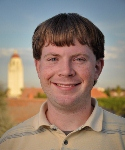
|
Brendan Tracey
Department of Aeronautics & Astronautics
Durand Building, Room 010a
Stanford, CA 94305
Background
- B.S. in Mechanical Engineering, University of Rochester, May 2008
- M.S. in Aeronautical and Astronautical Engineering, Stanford University, March 2010
Research Interests
I am researching the applicability of machine learning to turbulence modeling. For engineering applications, the Reynolds-averaged Navier Stokes equations (RANS) provide a nice balance between computational cost and accurracy. They are much more accurate than more simplified flows (such as panel methods and the Euler equations), and more accurate methods such as Large Eddy Simulation (LES) and Direct Numerical Simulation (DNS) are computationally intractible. The RANS equations, however, are not a closed set of equations, and additional equations must be provided. These additional equations are known as a turbulence model, and can have a large effect on the predicted solution. Traditionally, turbulence models are developed by making approximations to the Reynolds-stress transport equations, and then fitting a couple of constants to match simplified flows. While in many cases the RANS equations have sufficient accurancy, they can also be quite innaccurate, especially for flows with separation and large flow curvature.
The increase in computational power has greatly increased the number of availible high-fidelity LES and DNS flow solutions. Our idea is that rather than "develop" a turbulence model in the traditional manner, instead we should "learn" a turbulence model by applying machine learning techniques to the availible data.
While this idea has merit (at least in my opinion), many basic questions remain. What machine learning algorithms are most effective? How many data sets are needed? How well do learned turbulence models predict at new flows? What are the inputs and outputs to the learning model? Can these be selected automatically? My research seeks to answer some of these questions to try and pave a path forward for data-science driven turbulence modeling.
Other interests include:
- Combining game theory and engineering
- Optimization techniques and algorithms
- Renewable power systems and energy generation
Publications
|
Tracey, Brendan, David Wolpert, and Juan J. Alonso. "Using Supervised Learning to Improve Monte Carlo Integral Estimation." AIAA Journal (2013): 1-9. |
|
Tracey, Brendan, Karthik Duraisamy, and Juan J. Alonso. "Application of Supervised Learning to Quantify Uncertainties in Turbulence and Combustion Modeling." (2013). |
|
Lee, Ritchie, et al. "Counter-Factual Reinforcement Learning: How to Model Decision-Makers That Anticipate the Future." Decision Making and Imperfection. Springer Berlin Heidelberg, 2013. 101-128. |
|
E. J. Schlicht, R. Lee, D. H. Wolpert, M. J. Kochenderfer, and B. Tracey, "Predicting the behavior of interacting humans by fusing data from multiple sources," in Conference on Uncertainty in Artificial Intelligence, Catalina Island, California, 2012. |
|
Lee, R., Wolpert, D., Bono, J. Backhaus, S., Bent, R. and Tracey, B.,
"Modeling Humans as Reinforcement Learners: How to Predict Human
Behavior in Multi-Stage Games", 25th Annual Conference on Neural
Information Processing Systems, Granda, Spain, December 2011. |
|
Tracey, B. Wolpert, D. and Alonso, J., "Using Supervised Learning to Improve Monte Carlo Integral Estimation,"
13th AIAA Non-Deterministic Approaches Conference, Denver, CO, April 2011, AIAA Paper 2011-1843. |
| Daniels, M., Tracey, B., Irvine, J., Schram, W., Pate-Cornell, M.E., "Probabilistic simulation of multi-stage decisions for operation of a fractionated satellite mission," Aerospace Conference, 2011 IEEE , vol., no., pp.1-16, 5-12 March 2011. doi: 10.1109/AERO.2011.5747647 |
|

